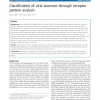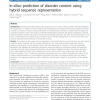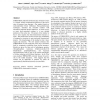31 search results - page 3 / 7 » Computational prediction of human proteins that can be secre... |
BMCBI
2011
13 years 24 days ago
2011
Background: Viral zoonosis, the transmission of a virus from its primary vertebrate reservoir species to humans, requires ubiquitous cellular proteins known as receptor proteins. ...
BIOINFORMATICS
2011
13 years 24 days ago
2011
Motivation: High-throughput methods for detecting molecular interactions have produced large sets of biological network data with much more yet to come. Analogous to sequence alig...
BMCBI
2011
12 years 9 months ago
2011
Background: Intrinsically disordered proteins play important roles in various cellular activities and their prevalence was implicated in a number of human diseases. The knowledge ...
APBC
2004
13 years 7 months ago
2004
THEMATICS (Theoretical Microscopic Titration Curves) is a simple, reliable computational predictor of the active sites of enzymes from structure. Our method, based on well-establi...
BMCBI
2004
13 years 5 months ago
2004
Background: In addition to known protein-coding genes, large amounts of apparently non-coding sequence are conserved between the human and mouse genomes. It seems reasonable to as...



